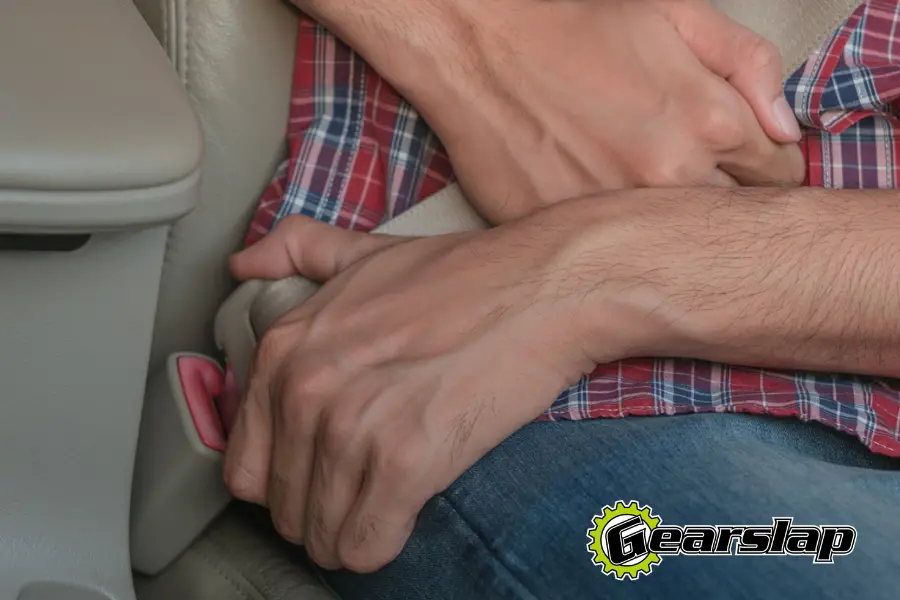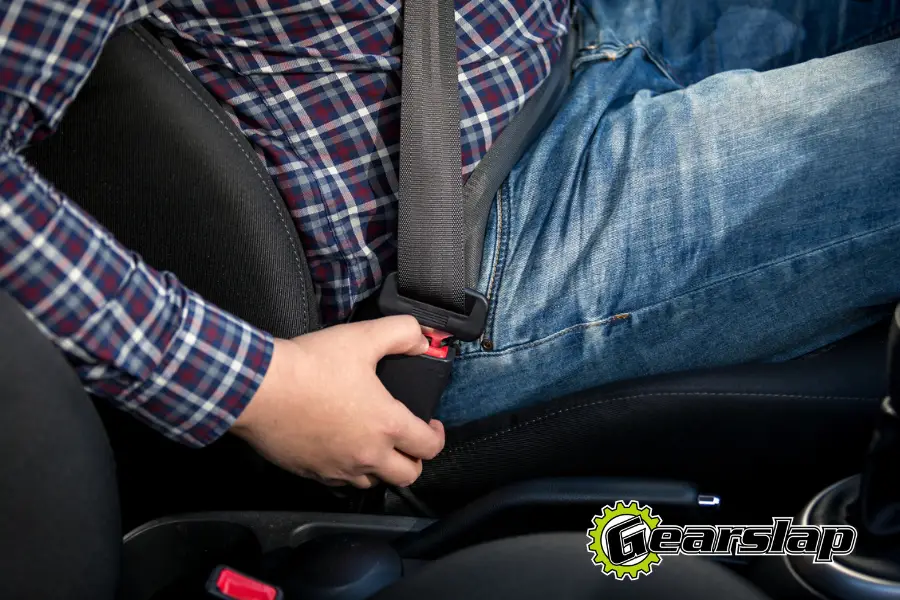The seat belts in my son’s Blazer are horrible! They’re floppy and don’t retract like they’re supposed to. So we decided to buy new ones and just replace them.
But sometimes the seatbelt works fine, but it’s stuck or jammed into the receiver. Let’s take a look at how you can fix a seat belt that’s stuck.
Seat belts are essential pieces of safety equipment in a car. Riding without a seat belt is illegal in the United States. However, seat belts don’t always work. If your seat belt jams, you should look into fixing it yourself before taking it to the manufacturer or repair shop.
How to Fix a Seat Belt that’s Stuck
We all know the frustration of a stuck seat belt. The mechanism that usually would save a life is stuck, and the seat belt is stuck too tight or won’t reel back in. If you’ve tried a few gentle tugs and it still doesn’t work, there could be several different issues. However, here’s the primary solution for a jammed seat belt.

What usually gets stuck is the seat belt retractor. This allows the belt to loosen and fit any passenger but tighten in an emergency. The belt will automatically tighten if the car lurches or brakes suddenly. However, if you pull too quickly, it can jam.
This is the most common issue with seat belts, but fortunately, it is also easy. To unjam a locked seat belt, gently pull on it a few times. It should take a few gentle tugs before the seat belt unlocks and loosens. From there, you should be able to return the seat belt to the proper length. Doing this every so often along with regular car maintenance should prevent jams.
How Do You Unjam a Seat Belt Latch?
However, other parts of a seat belt can get caught. If you have tried unjamming the retractor and it still doesn’t work, it could be that the latch is the issue. This becomes a very time-sensitive issue if you have a kid stuck in the car because of the buckle.
There are two main ways to deal with a stuck seat belt buckle. If the latch sticks in the buckle, you can use WD-40 or another type of lubricant. Spray a small amount around the edges of the opening, and let it drip into where the latch is stuck. This should loosen whatever is stuck and make everything smooth.
If the problem persists, you can take rubbing alcohol and dab it on a q-tip. Clean off the buckle itself and the opening of the latch. This should clean out any gunk leftover from the oil and ensure a smooth hitching process. Test it before buckling anyone in so that no one gets stuck.
Of course, if the seat belt is trapping someone in the car, don’t hesitate to cut through the seat belt webbing. You will have to replace the belt after this totally, but one replaced seat belt is worth it to save someone’s life. Be careful when you cut through a seat belt or use oil. If that’s the only method you have, use it, but be cautious to avoid injury to the person or yourself.

How Do You Fix a Seat Belt that Won’t Retract?
The most common issue with a seat belt is that it won’t loosen. However, some seat belt retraction systems break, and they become slack. A completely slack seat belt is just as big an issue as it can’t tighten and prevent someone from crashing through the front windshield in the event of an accident.
A twist or jam within the loop is the most likely reason for a non-retracting seat belt. Pull the seat belt out slowly to diagnose the problem, checking for twists along the way. If you’ve pulled the seat belt out to its full extension and it doesn’t retract, it’s time to move on to step two.
If you aren’t dealing with a jammed or twisted seat belt, it’s time to check the retractor. Depending on the model, you’ll have to take off the shield that covers the retractor (the bottom or top part of the seat belt). In some cases, such as backseats, you might have to remove the seat to access the start of the seat belt.
Once you remove the shielding around the retractor, the answer will become clear. You either need to untangle the belt from the retractor itself or check to see if the internal mechanism has suffered damage. If that’s the case, the best thing to do is completely replace the seat belt. Using a seatbelt with a broken retractor could be a safety issue.
How Do You Fix a Seat Belt That Won’t Move?
If your seat belt won’t move in or out, it’s likely jammed. Take steps to unjam it as listed above. If these don’t work, consider uninstalling and reinstalling the belt itself. It might need extra oil to unjam, or the mechanism may have stopped working.
Once you’ve tried all the options and the seat belt still isn’t moving, take it to a mechanic or replace it yourself. It’s not a difficult process, but it can be time-consuming, depending on how intricate the seat belt mechanism is in your car’s make and model.
How Do You Replace a Seat Belt Yourself?
You can replace a seat belt if you have the correct tools. It takes several steps but is similar to the steps you might take to fix a seat belt. You’ll need to remove the entire seat belt mechanism, from belt to retractor, and put a new one in.
The parts for a seat belt replacement can be somewhat expensive, but you must get factory-made parts instead of cheaper replacements. Buying the correct seat belt for your car’s make and model will prevent mishaps with your new belt.
Once you’ve removed the retractor shield, you should see some screws to remove the retractor itself. In some models, the retractor is under the seats or the car’s floor. If this is the case, you might need to take it to a repair shop for assistance. Otherwise, remove the retractor and replace it, following instructions.
The exact method for removing and replacing your seat belt retractor depends on the make and model of your car and seat belt. However, most are relatively simple. Unless they track through the ceiling or floor of a car, you shouldn’t need to take apart your vehicle too much.

Once you’ve replaced the retractor, loop the belt back through the proper mechanisms and latch it to the seat. Always test your belt several times by buckling it in and pulling it quickly on the belt a few times. If it catches properly, you’ve installed it well.
Of course, if anything goes wrong, you can always take your car to a repair shop. As with any car repair project, it’s better to be safe than sorry, and a mechanic can tell you exactly what went wrong and fix it for you. The main priority is keeping your passengers safe, which is more important than saving some money.
Frequently Asked Questions
Here are some frequently asked questions about stuck seat belts and how they get jammed.
How do seat belts get stuck?
The most common way a seat belt locks is from the belt jamming or twisting itself. The mechanism of a seat belt is simple but programmed to stop the belt from moving if it’s jerked too quickly.
Because of this, seat belts can jam when yanked on or when the car brakes suddenly. Alternatively, the belt portion can get twisted and prevent the seat belt from loosening or tightening properly, creating a stuck belt.
How much does it cost to fix a jammed seat belt?
If you take your seat belt to a maintenance specialist, it will likely cost several hundred dollars to assess and fix the issue. In some cases, this is necessary. If your seat belt needs a complete replacement, a licensed mechanic can do this safely and securely with factory-made parts. However, it’s also possible to do it yourself.
For a simple jam, it’s best to try the home-based remedies before taking them to a professional. After you’ve tugged on the belt a few times and tried to loosen it at home, you can replace the entire belt yourself or let a professional mechanic do it.

Can a seat belt be repaired?
In some cases, seat belts can be repaired. However, it depends on the amount of damage. It will probably be better to replace the entire mechanism with a broken retractor or a torn belt. Fortunately, this isn’t too expensive other than the part, and you should be able to do it at home.
For most other situations, however, you can repair a seat belt on your own. All you have to do is assess the situation and unjam the seat belt. Usually, this isn’t too difficult, as long as you know what you’re looking for.
When are seat belts most likely to get stuck?
Seat belts get stuck all the time, but in life-threatening scenarios, the seat belt will most likely get stuck during an accident. Even if you have to cut through the seat belt to get out, that’s much better than being unrestrained in the car. 51% of passengers in fatal vehicle collisions died because they weren’t wearing their seat belts, so buckle up!
